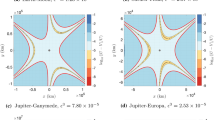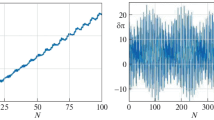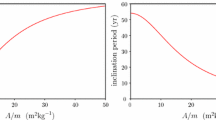Abstract
We describe an approximate numerical-analytical method for calculating the perturbations of the elements of distant satellite orbits. The model for the motion of a distant satellite includes the solar attraction and the eccentricity and ecliptic inclination of the orbit of the central planet. In addition, we take into account the variations in planetary orbital elements with time due to secular perturbations. Our work is based on Zeipel’s method for constructing the canonical transformations that relate osculating satellite orbital elements to the mean ones. The corresponding transformation of the Hamiltonian is used to construct an evolution system of equations for mean elements. The numerical solution of this system free from rapidly oscillating functions and the inverse transformation from the mean to osculating elements allows the evolution of distant satellite orbits to be studied on long time scales on the order of several hundred or thousand satellite orbital periods.
Similar content being viewed by others
References
J. Kovalevsky, Acad. Sci. 258(18) (1964).
J. Kovalevsky, IAU Symp. No. 25, Ed. by G. I. Kontopoulos (Academ. Press, London, 1966), p. 326.
Y. Kozai, Astron. J. 67, 591 (1962).
M. L. Lidov, Iskustvennye Sputniki Zemli 8, 5 (1961).
M. L. Lidov, Tr. Inst. Teor. Atron. XVII 54 (1978).
A. A. Orlov, Byull. Inst. Teor. Atron. X 5(118), 360 (1965a).
A. A. Orlov, Proc. of XV Intern. Congress on Astronautics (Gauthier-Villars, Paris, 1965b), Vol. 1.
A. A. Orlov, Vestn. Mosk. Univ., Fiz., Astron. 6, 104 (1969).
A. A. Orlov, Byull. Inst. Teor. Atron. XII 2(135), 195 (1970a).
A. A. Orlov, Byull. Inst. Teor. Atron. XII 3(136), 302 (1970b).
A. A. Orlov, Tr. Gos. Astron. Inst. im P. K. Shternberga XLIII 2, 30 (1972).
M. A. Vashkov’yak and N. M. Teslenko, Pis’ma Astron. Zh. 24, 474 (1998) [Astron. Lett. 24, 406 (1998)].
Author information
Authors and Affiliations
Additional information
__________
Translated from Pis’ma v Astronomicheski\(\overset{\lower0.5em\hbox{$\smash{\scriptscriptstyle\smile}$}}{l}\) Zhurnal, Vol. 31, No. 1, 2005, pp. 66–75.
Original Russian Text Copyright © 2005 by Vashkov’Yak.
Rights and permissions
About this article
Cite this article
Vashkov’yak, M.A. A numerical-analytical method for studying the orbital evolution of distant planetary satellites. Astron. Lett. 31, 64–72 (2005). https://doi.org/10.1134/1.1854797
Received:
Issue Date:
DOI: https://doi.org/10.1134/1.1854797




